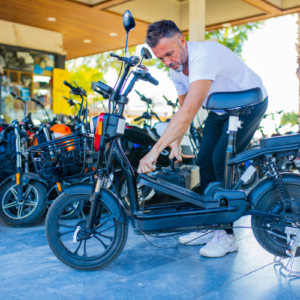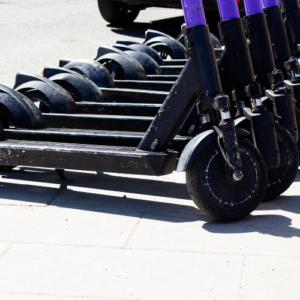How to Charge an Electric Scooter without a Charger
There are many good reasons why you might want to understand how to charge an electric scooter without a charger. For example your original charger might be faulty, or you might have forgotten your charger entirely and need to recharge in a pinch.
Read on for some great tips on charging an E scooter without a charger. Please bear in mind that best case scenario will always be the use of your scooter’s original charger, and you should only try these other options if you really don’t have an other option.
Electric scooters have surged in popularity due to their convenience, sustainability, and fun factor. However, the heart of these eco-friendly rides is their battery, which, when depleted, can leave you stranded or reduce your scooter’s performance significantly. But what happens when you don’t have access to the scooter’s charger? Whether you’ve misplaced it, it’s damaged, or you’re simply out and about and need a charge, there are innovative ways to recharge your electric scooter without the standard charger.
Understanding Electric Scooter Batteries
Most electric scooters are powered by lithium-ion batteries, which are universally lauded for their high energy density and longevity.
These batteries require DC power (Direct Current) to recharge, and this is a process which typically facilitated by the scooter’s AC charger, which of course converts household AC power (Alternating Current) into the DC power needed by the battery. Knowing the basics of how these batteries operate is definitely worthwhile when you are looking at alternative charging methods for your electric scooter.

Alternative Charging Methods – 7 Ideas on How to Charge your Electric Scooter without a Charger
1. Using a Power Bank
Portable power banks aren’t just for smartphones and tablets; they can also revive your electric scooter’s battery in a pinch. To use a power bank for charging, you’ll need a USB-to-DC adapter compatible with your scooter’s battery port. While power banks offer a convenient and portable solution, their capacity may be insufficient for a full charge, especially for larger scooter batteries.
That may not matter however if you just need an extra boost to get you home until you can fully charge your battery for next time. Consider using a portable power bank as a back up plan for unforeseen circumstances.
2. Solar Panels
For the eco-conscious rider, solar panels provide a green alternative to charging your scooter. You’ll need a solar panel with a charge controller to prevent overcharging and a compatible battery charger adapter. This method is ideal for off-grid adventures or as a sustainable charging solution at home.
Again, while you can charge your phone or tablet with this charger you can also use it for your electric scooter. Solar powered chargers can be a great option for charging your electric scooter, especially if you are out on an off road adventure, or you can leave your scooter outside safely while you work.
3. Generators
If you find yourself in areas without reliable electricity, a generator could potentially be a lifesaver. Connect your electric scooter’s battery to a generator via a compatible battery charger that supports generator input.
It’s worth mentioning that this method requires careful attention to the generator’s output to ensure it matches your scooter’s charging requirements. It also comes with the realisation that you may find a generator difficult to locate depending on your circumstances, however it’s an important mention on the topic of how to charge your electric scooter without a charger.
4. Public Charging Stations
As electric transport is becoming more and more of an option, so does the infrastructure to support it.
Some urban areas and businesses have begun offering charging stations for electric scooters and bikes. These stations provide a convenient way to charge on the go, though availability may vary, and there could be a fee. It’s also worth considering that there be a queue or high demand for the station, so plan ahead.
5. Car Chargers
If you have access to a car, you can use a car charger adapter designed for electric scooters. These adapters plug into the car’s cigarette lighter socket, providing a charging solution on the move. Be careful you don’t deplete the car battery completely.
It’s crucial to monitor the charging process closely to prevent overcharging or overheating, as the car’s electrical system may offer a higher output than what your scooter’s battery requires. This is a last ditch method and not one that you should see as a regular go to way to charge your electric scooter.
6. Jumpstarting with Another Scooter or Vehicle
This method involves using the battery of another electric scooter or a compatible vehicle to give your scooter’s battery a boost. It’s particularly useful if your scooter’s battery is completely drained. Here’s how to do it safely:
- Ensure Compatibility: Check that both batteries (the donor and the recipient) operate at similar voltages to avoid damaging the electrical systems.
- Use Proper Cables: Employ jumper cables specifically designed for use with electric scooters or small vehicles. These cables ensure that the current flow is appropriate for the batteries involved.
- Connect Correctly: Attach the positive (red) clamp to the positive terminal of the dead battery and the other positive clamp to the donor battery. Repeat with the negative (black) clamps. Ensure all connections are secure before proceeding.
- Start the Donor Scooter: Turn on the donor scooter or vehicle to begin the jumpstarting process. Allow it to run for a few minutes to transfer some charge to the dead battery.
- Attempt to Start Your Scooter: After a few minutes, try to start your electric scooter. If it starts, disconnect the jumper cables in the reverse order of how they were attached.
Safety Note: This method should be used with caution. Always consult your scooter’s manual or a professional if unsure, as incorrect jumpstarting can lead to battery damage or personal injury.
7. Utilizing Regenerative Braking
Regenerative braking is a feature found in some electric scooters that converts the kinetic energy generated during braking into electrical energy, which is then used to recharge the battery. This method is particularly beneficial in the following scenarios:
- Downhill Rides: When riding downhill, use the scooter’s braking system to generate and store energy back into the battery.
- Decelerating: Instead of coming to abrupt stops, use gentle deceleration to activate the regenerative braking system, allowing more energy to be captured and stored.
- Strategic Braking: Plan your rides to maximize the use of regenerative braking, such as choosing routes with slopes or incorporating stop-and-go riding in traffic, which can help recharge the battery over time.
Efficiency Tips: While regenerative braking can help extend your ride, it’s important to remember that its effectiveness varies based on the scooter model, terrain, and riding style. It’s a supplementary charging method that works best in conjunction with traditional charging practices.
Try the following link or more ideas on electric scooter maintenance.

Safety and Precautions
Regardless of the alternative charging method you choose, safety should always be your top priority. Electric scooters and their batteries are sophisticated devices that require proper handling to avoid damage or accidents. Always follow these guidelines:
- Use Compatible Equipment: Ensure any adapters or cables are compatible with your scooter’s battery specifications.
- Monitor the Charging Process: Never leave your scooter unattended while it’s charging through unconventional means. Watch for signs of overheating or unusual battery behavior.
- Protective Gear: When handling solar panels or setting up any makeshift charging setup, use gloves and protective eyewear as necessary.
- Consult the Manual: Refer to your scooter’s user manual for specific charging recommendations and safety tips.
Final Thoughts
Charging your electric scooter without the original charger is possible, but it requires caution, the right equipment, and a bit of ingenuity. Whether you opt for a power bank, solar panel, generator, public charging station, or car charger, always prioritize safety and battery health. Remember, these methods should be seen as temporary solutions rather than permanent alternatives to using the designated charger. For the best performance and longevity of your electric scooter, using the manufacturer-recommended charger and following their guidelines remains the safest and most effective approach.
Adding to the innovative methods to charge an electric scooter without the standard charger, we explore two additional alternative charging techniques that could come in handy, especially when conventional charging options are not available.
FAQ’s About How to Charge an Electric Scooter without a Charger
What can I use to Charge my Electric Scooter?
You can use a USB cable if you have to to charge an electric scooter which has a compatible USB port in a pinch. You can also charge your electric scooter at certain electric car charging stations. Make sure the battery is compatible. It’s also possible to ensure your electric scooter will be up and running by replacing the battery with a previously charged one or using a portable charger.
Can you Charge a Electric Scooter with a Different Charger?
Always bear in mind that your electric scooter’s original charger will be better than a different charger, however you can definitely buy a universal charger that is compatible with your scooter provided you do your homework first. A simple check of specifications, voltage, and amperage compatibility will ensure you can charge your electric scooter with a different charger.
